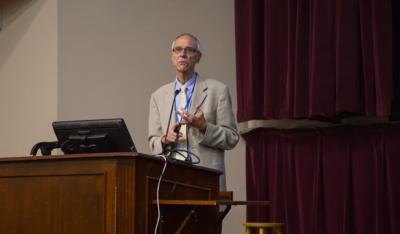Hosts International Civil Aviation English Association (ICAEA) Conference On Communication
On Aug. 14, 2005, a Helios Airways Boeing 737-300, en route from Lanarco to Prague by way of Athens climbed to 16,000 feet altitude before the captain reported an alarm. For eight minutes, the Boeing flew to 28,900 feet while the captain communicated with a ground team. Passenger oxygen masks deployed. Transmissions went silent. Fighter jet pilots, once airborne, saw the Boeing’s first officer slumped over the controls.

The aircraft crashed into a hillside, killing all 121 souls onboard.
Hypoxia resulting from a pressurization mode selector left in the “manual” position was reported as the cause of the accident, linguist Elizabeth Mathews noted May 9 at the International Civil Aviation English Association (ICAEA) conference on communication as a factor in aircraft accidents, hosted by Embry-Riddle.
However, an accident report made multiple references to a “lack of clarity in message” from the Boeing’s commander, said Mathews, an assistant professor of aerospace and occupational safety on Embry-Riddle’s Daytona Beach, FL campus. Moreover, the German captain and the Cypriot co-pilot “tried to solve the problem but encountered some problems communicating with each other,” according to the Aviation Safety Network (ASN) database.
“Language as a possible contributing or latent factor in aviation accidents should be investigated with the same degree of methodical and systematic thoroughness with which all other human and operational factors related to aviation safety are considered,” said Mathews, a former linguistic consultant to the International Civil Aviation Organization (ICAO), a United Nations assembly that establishes safety standards.
To provide clarity on the role of miscommunication in aircraft accidents, Mathews and her collaborators have undertaken a systematic global study of fatal events from 1990 to 2012. The team – including Mathews’ faculty colleagues David Williams, Anthony Brickhouse and Jennifer Roberts and graduate student Steven Singleton – has been scouring accident investigation reports. They are leveraging a specially developed taxonomy based on the well regarded Human Factors Analysis and Classification System framework, co-developed by Scott Shappell, chair of Human Factors and Behavioral Neurobiology.
Understanding language as a factor in aircraft accidents urgently requires objective research, said conference keynote speaker Captain Daniel Maurino, safety management advisor with the ICAO Technical Cooperation Bureau.
In the past, however, accident investigators did not typically look for communication issues. Deep dives into accident reports have tended to turn up small numbers of language-related cases. When he searched 42,000 records of accidents maintained within an ICAO database, for example, Maurino found only 81 attributed to communication issues.
Yet, aspiring pilots, controllers and technicians need improved training, at an early age, in speaking and reading aviation English, he said. ICAO standards currently require pilots and controllers to achieve “operational Level 4” proficiency in English.
Former airline pilot Tom Nichols, another speaker at the conference, noted that the world will need some 617,000 additional pilots by 2035. Yet, across many regions such as Asia, Mexico, South America and parts of Africa, English proficiency ranges from 5% to 15%.
“The multicultural cockpit is a growing phenomenon in the world,” he said. Helping young people learn English before they enter aviation fields will require significant funding.
Rarely hosted by a university, the ICAEA conference brought attendees from 41 different nations to the Embry-Riddle campus. Participants included pilots, maintenance specialists, trainers, civil aviation authorities, academicians and many others.
(Image provided with ERAU news release. Photographer: Jasmine Johnson)
 ANN's Daily Aero-Linx (04.16.24)
ANN's Daily Aero-Linx (04.16.24) Aero-News: Quote of the Day (04.16.24)
Aero-News: Quote of the Day (04.16.24) Airborne 04.10.24: SnF24!, A50 Heritage Reveal, HeliCycle!, Montaer MC-01
Airborne 04.10.24: SnF24!, A50 Heritage Reveal, HeliCycle!, Montaer MC-01 Airborne 04.12.24: SnF24!, G100UL Is Here, Holy Micro, Plane Tags
Airborne 04.12.24: SnF24!, G100UL Is Here, Holy Micro, Plane Tags Airborne-Flight Training 04.17.24: Feds Need Controllers, Spirit Delay, Redbird
Airborne-Flight Training 04.17.24: Feds Need Controllers, Spirit Delay, Redbird



